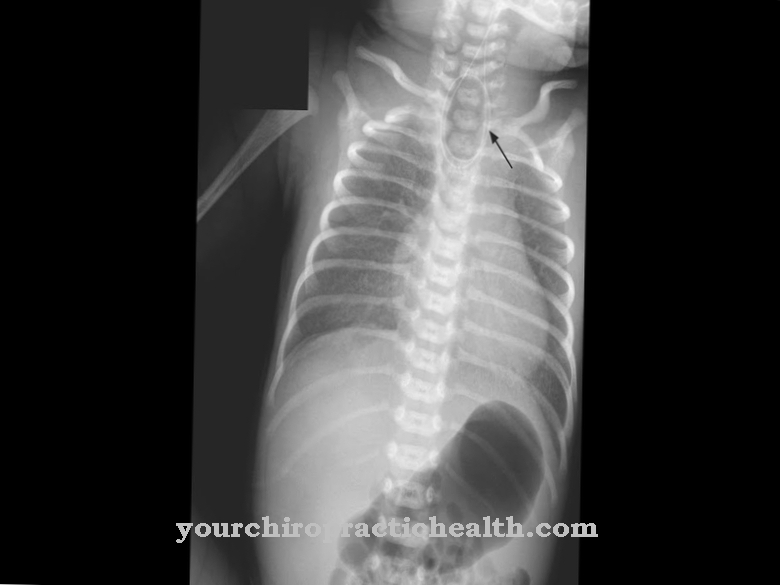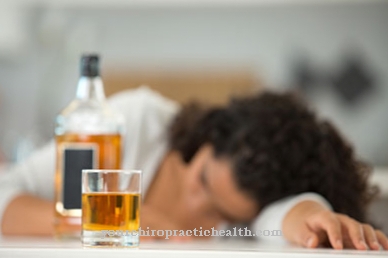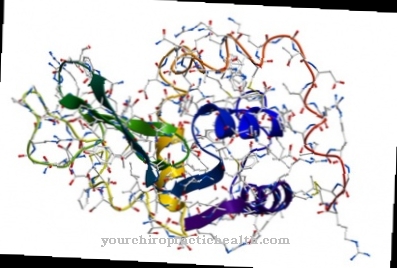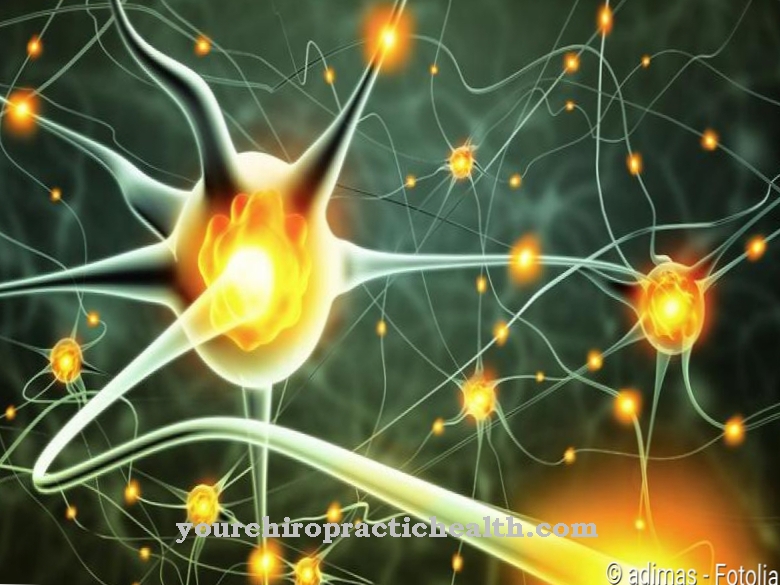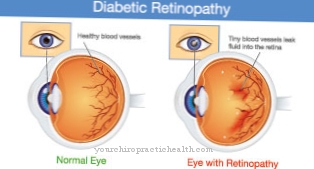At a Hyperbilirubinemia if the blood concentration of bilirubin exceeds the normal value. The result is jaundice, as the yellowish substance is deposited in the skin. Treatment depends on the underlying disease.
What is hyperbilirubinemia?

© Alessandro Grandini - stock.adobe.com
Bilirubin corresponds to a yellowish breakdown product that comes from the heme component of the red blood pigment hemoglobin. This makes the bilirubin a bile pigment. Red blood cells have a lifespan of around 120 days and after this period are broken down within the liver and spleen. After intermediate stages, the red blood pigment becomes bilirubin.
The bilirubin produced daily amounts to around 300 milligrams and around 80 percent comes from the erythrocyte breakdown processes. In the blood, the bilirubin is made to bind non-covalently to albumin. The protein-coupled bilirubin corresponds to unconjugated bilirubin. Delta bilirubin is used in a covalent bond with albumin. With a so-called Hyperbilirubinemia the bilirubin concentration in the blood increases to values above 1.1 mg / dl.
When the serum levels of the breakdown substance are elevated, symptoms such as jaundice occur as the bilirubin builds up in the skin. Additional symptoms may occur depending on the cause and type of the increase in bilirubin. Hyperbilirubinemia is not itself a disease in itself. Rather, it is a symptom of a superordinate disease that manifests itself in the form of a disruption in the breakdown of bilirubin.
In connection with increased total bilirubin, a distinction is made between indirect and direct hyperbilirubinemia. Indirect bilirubin has poor solubility. Only after processes of biotransformation develop more soluble bilirubin within the liver, which can be detected as direct bilirubin.
causes
The cause of hyperbilirubinemia is always a disturbance in the breakdown of the waste product. The breakdown is a symptom of various diseases. Therefore, hyperbilirubinemia can have a variety of causes. For example, indirect hyperbilirubinemia with more than 80 percent of total bilirubin in the form of indirect hyperbilirubin can indicate hemolysis. However, this symptom may just as well be related to rhabdomyolysis, burns, or neonatal icterus.
In newborns, an increased value is physiologically conditioned and is considered to be normally increased to a certain extent. Your liver is not yet working fully and therefore breaks down much less bilirubin. A distinction must be made between the causes of hyperbilirubinemia with a small proportion of direct bilirubin and intrahepatic jaundice, which have just been mentioned, for hyperbilirubinemia with more than 80 percent of total bilirubin and indirect hyperbilirubin.
In this context, Gilbert's disease, Crigler-Najjar syndrome, Dubin-Johnson syndrome or Rotor syndrome can be possible causes. The same applies to hepatitis, liver cirrhosis or severe intoxication with alcohol, drugs or aflatoxins.
Salmonellosis, cholangitis and leptospirosis must also be considered as causative factors for this form of hyperbilirubinemia. In the case of directly emphasized hyperbilirubinemia with little indirect component and occlusive jaundice, on the other hand, causes such as cholelithiasis, pancreatic carcinoma, bile duct carcinoma or bile duct atresia are sometimes the most common.
Symptoms, ailments & signs
Hyperbilirubinemia can manifest itself in clinically different symptoms. In principle, an asymptomatic course is quite possible, for example in the context of diseases such as Meulengracht's disease. Normally, however, at least the symptom of jaundice occurs. Jaundice corresponds to jaundice and, depending on the disease, can be prehepatic, intrahepatic or posthepatic in individual cases.
The stage of hyperbulirubinemia affects the degree of jaundice present. First of all, a gel coloration of the sclera occurs, which is due to the deposits of increased bilirubin. Depending on the cause and type of hyperbilirubinemia, other symptoms and complaints can occur, for example nausea and vomiting, abdominal pain and diarrhea. Some patients have a fever and fatigue. The symptoms usually appear immediately after the onset of the causative disease and persist for several days to weeks.
Over time, the degradation product is also stored in the rest of the skin and can cause discoloration all over the body. In later stages a deposit builds up in the internal organs and all other tissues of the body. Thus, with late hyperbilirubinemia, the inner tissues of the person affected also turn yellow.
When bilirubin crosses the blood-brain barrier in the context of various diseases, developmental disorders can appear accompanying the deposits. Storage in vital organs can also be accompanied by symptoms and functional losses in the affected organs. Depending on the underlying disease, there may also be disease-specific symptoms, such as itchy skin.
Diagnosis & course of disease
Bilirubin is determined in the serum. Determination in EDTA blood or heparin whole blood is also possible. When diagnosing hyperbilirubinemia, the doctor compares the total bilirubin with the normal values. If it is more than 1.1 mg / dl, hyperbilirubinemia is present. In addition, the doctor must determine whether it is a direct or indirect hyperbilirubinemia.
Limit values of 0.25 mg / dl apply to direct bilirubin. For indirect bilirubin, they are 0.8 mg / dl. Different reference ranges apply to infants. The determination of the cause depends on the general clinical picture and usually includes further imaging.
Complications
Hyperbilirubinemia, i.e. an excess of bilirubin above the normal value, occurs primarily in the context of jaundice (icterus). Jaundice can have various causes and complications. Prehepatic jaundice is often caused by increased hemolysis, i.e. the breakdown of red blood cells, which can lead to anemia.
This is characterized by a sharp drop in performance, fatigue and weakness. With hepatic jaundice, the problem lies in the liver. In addition to a few harmless enzyme defects, hepatitis or cirrhosis of the liver can also be the cause of hyperbilirubinemia.If left untreated, hepatitis can lead to cirrhosis of the liver in some cases, which can subsequently degenerate into liver cancer.
Liver cancer is a dangerous tumor that is fatal if diagnosed too late. The 5-year survival rate is just 10 percent. Posthepatic jaundice is mostly due to cholestasis, that is, backlog of bile. The constant back pressure can lead to inflammation and possibly also to bile duct carcinoma.
In newborns, increased bilirubin levels are usually normal and go away again after a few days. However, if it does not return to normal and increases, it can lead to kernicterus. This is serious damage to the central nervous system and can lead to weakness, unwillingness to drink and a lack of reflexes. If left untreated, the disease can later lead to consequential psychomotor damage and seizures.
When should you go to the doctor?
Hyperbilirubinemia is expressed as jaundice. Like jaundice, hyperbilirubinemia is not an independent disease, but a symptom. Hyperbilirubinemia is an underlying disease in which the breakdown of bilirubin from red blood cells is impeded. There are many different diseases that can be considered as possible triggers, for example:
- hepatitis
- Cirrhosis of the liver
- Gallstones
- Biliary tract cancer
- Inflammation of the bile duct
- Pancreatic cancer
- salmonellosis
- Alcohol poisoning
- Substance abuse
Hyperbilirubinemia can also occur in neonatal jaundice.
The course of treatment is as varied as the disease underlying hyperbilirubinemia. It makes sense to first see your family doctor. After the first initial examinations, he decides which other specialists to call in for therapy. Internists, gastroenterologists and oncologists are the main candidates. There are also a few hereditary diseases that lead to hyperbilirubinemia such as Rotor Syndrome, Dubin-Johnson Syndrome and Crigler-Najjar Syndrome.
People who suffer from a loss of their usual level of performance or general weakness should consult a doctor. If the symptoms persist over a longer period of time or if they intensify, a check-up visit with a doctor is necessary. Fatigue despite getting enough night's sleep, a lack of concentration or attention, and a feeling of illness are reasons for a doctor's visit. Discoloration of the skin and especially a yellow complexion should be examined and treated.
If the stool is clay-colored or urine is dark-colored, a doctor should be consulted. The changes indicate conditions that need to be investigated and treated. Persistent fatigue, loss of appetite or a loss of participation in social life should be clarified by a doctor. Unwanted weight loss is to be understood as a warning from the organism. A doctor should be consulted if it occurs and makes you feel unwell.
If the daily duties or activities can no longer be carried out, a doctor is required. If the consciousness is disturbed, the disease is already advanced. An emergency doctor must be called as soon as there is a loss of consciousness. First aid measures are necessary to ensure the survival of the person concerned. If there is a weak heart, abnormalities in the circulatory system or circulatory disorders, a doctor must be consulted.
Doctors & therapists in your area
Treatment & Therapy
In many cases, therapy for hyperbilirubinemia is not necessary. Basically, attention is usually paid to the causative primary disease. If this disease corresponds to Rotor or Dubin-Johnson syndrome, for example, therapeutic steps are generally not required.
If hepatitis is present, treatment can range from conservative medication with antiviral drugs to immunosuppressants and liver transplants. If the cause of hyperbilirubinemia can be resolved, the overconcentration of the substance in the blood will decrease.
If the deposits do not come off the skin, phototherapy can take place. The bilirubin stored in the skin is converted into a water-soluble substance during this phototherapy. This water-soluble substance corresponds to lumirubin, which thanks to its solubility can easily be excreted from the body.
Outlook & forecast
Hyperbilirubinemia causes jaundice in most people. This can occur for many different reasons, which is why a general prognosis is not possible. If hyperbilirubinemia occurs as a result of alcohol and drug abuse, the drugs must be discontinued and withdrawal may have to be carried out.
In other cases, hyperbilirubinemia occurs due to gallstones or biliary inflammation, which must be treated by a doctor. The anemia usually leads to a feeling of weakness. Often the person concerned feels listless and tired and can no longer perform physical activities. This can lead to underweight and damage to the extremities.
The treatment always deals with the causal disease. If it is hepatitis, a liver transplant or medication can be given. As a rule, this limits the hyperbilirubinemia relatively well.
In many cases, however, no treatment is necessary if there is no underlying health-threatening disease that leads to hyperbilirubinemia. In any case, the person affected should still consult their family doctor so that the cause of the hyperbilirubinemia can be determined.
prevention
Hyperbilirubinemia can only be prevented to the extent that the causal diseases can be prevented.
Aftercare
In the case of hyperbilirubinemia, the person affected usually has very few measures and options for follow-up care available. In the case of this disease, a doctor should be contacted at an early stage so that the disease can be diagnosed and treated at an early stage. Therefore, a doctor should be consulted at the first signs and symptoms of the disease.
Self-healing cannot occur, so treatment by a doctor is always necessary for this disease. Therapy is only required in a very few cases. Even without therapy, however, regular examinations of the internal organs by a doctor are very important in order to prevent further complications.
In many cases, this disease makes patients dependent on taking medication. When taking this, attention should be paid to correct and, above all, regular intake. If you have any questions or are in doubt, you should always contact a doctor first.
In severe cases, however, organ transplantation is necessary. Bed rest should be observed after such an operation. The person concerned must not exert himself unnecessarily and usually also needs the care and support of the family.
You can do that yourself
Since hyperbilirubinemia occurs as a symptom of a wide range of underlying diseases, no general advice can be given. It is important to strictly follow medical instructions, to take medication regularly and to avoid triggering substances. With prognostically benign causes such as Gilbert's disease or Rotor syndrome, life is also possible without any impairment in everyday life.
The greatest influence on the quality of life results from jaundice, i.e. visible bilirubin deposits in the sclera of the eyes and the epidermis. This is mostly a purely cosmetic problem. Not every patient is affected, as this symptom only appears at bilirubin concentrations of over 2 µg / dl in the blood. It is completely reversible for underlying diseases that can be successfully treated.
Radiation of light on the skin can make a - albeit small - contribution to the breakdown of the bilirubin visible on the surface. For this reason, it is advisable not to put make-up on the affected areas or to keep them covered in the fresh air.
In the case of hyperbilirubinemia that can be traced back to substance abuse, in addition to therapeutic measures, self-responsible steps can also be sought. Visiting relevant self-help groups and participating in abstinence programs can be an important pillar in treatment that the patient carries out independently of doctors.

